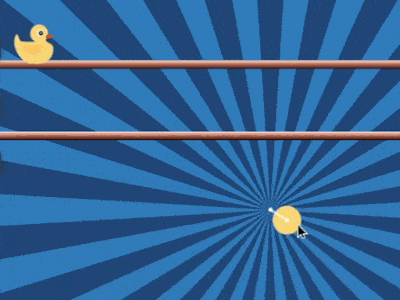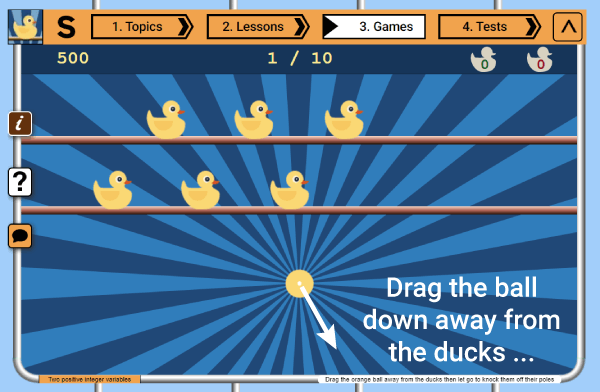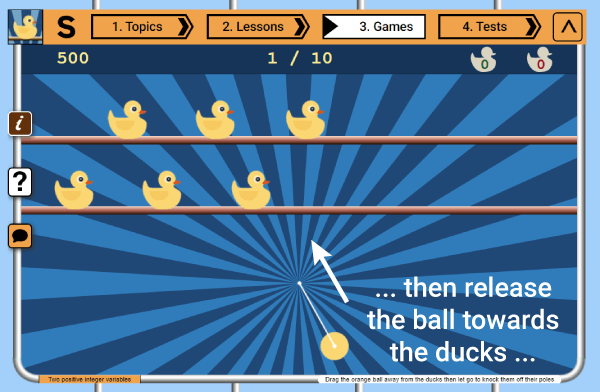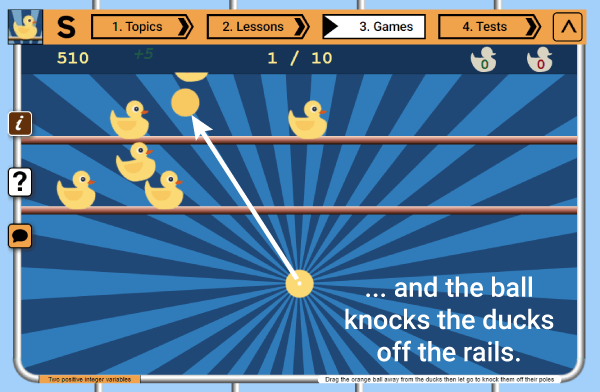


3 scores max per player; No foul language, show respect for other players, etc.
Name | Score | Date | ||
|---|---|---|---|---|
| 1 | ||||
| 2 | ||||
| 3 | ||||
| 4 | ||||
| 5 | ||||
| 6 | ||||
| 7 | ||||
| 8 | ||||
| 9 | ||||
| 10 |

Game: DUCK SHOOT
Aim: Shoot as many ducks as you can
Method:
Use the catapult to shoot balls at the rows of ducks crossing the screen. Answer questions to win extra points.
Your final score is based on ducks hit or missed and the number of questions answered correctly.

anonymous 🥰
"Which fraction is biggest"
The DUCK SHOOT game to practice
'Grouped frequency tables' for 8th grade
8th grade / Statistics / Continuous data / Continuous grouped data / Grouped frequency tables
Grouped frequency tables
Data in frequency tables can be discrete or continuous. Discrete data consists of single values, often whole numbers, and is how most data is initially gathered. If there are many data points to process, it becomes useful to group that data into a set of classes of continuous data. Continuous data can be represented in a "Grouped frequency table". Each class covers the data points within a certain range, and the classes together cover the entire range of all the data points. In grouped frequency tables, it is important that the classes cover the entire range of the given data while not overlapping.
The benefit of grouped frequency tables becomes clear when there are so many raw data points that discrete values would become difficult to process. A limitation of continuous data is that individual data points are lost so that exact calculations of the mode, median or range of the original discrete data points becomes impossible.
In this topic you are asked to compare each grouped frequency table to the raw data that it should represent. Many of the tables have deliberate mistakes that you must identify. You can do so by counting up the data points for each class and comparing them to the given frequencies.
In the first question, the raw discrete data points are:
10, 8, 25, 18, 15, 22, 5 ,9
The grouped frequency table splits the data into classes: 1-10, 11-20, 21-30.
The frequency for the 1-10 class is given as 4. We can look through the data points and confirm that there are indeed 4 values within this range: 10, 8, 5 and 9. So that frequency is correct. Checking the 2 other classes shows us that the table does indeed accurately represent the data, so the answer in this case is "yes, the table does match the data".
With our Duck shoot math game you will be practicing the topic "Grouped frequency tables" from 8th grade / Statistics / Continuous data / Continuous data. The math in this game consists of 16 questions that ask you to in each instance decide whether the grouped frequency table matches the raw data.

DUCK SHOOT is a fun game to learn math where you attempt to knock over all the fairground ducks in each level. In the first level there are only 6 ducks but by level 10 there are 24 fast moving "quackers quacking"...
After each level, win an additional 20 points by correctly answering a math question from your selected topic. There is no timer in this game: take as long as you like to answer the math questions correctly for a best score to get you on the DUCK SHOOT leaderboard.
Notes
- This is a fun game of knocking over as many tin ducks as you can
- Also suitable for tablets and mobiles (it's actually more fun than with a mouse)
- Answer math questions correctly for a higher score
- No timer element, you can relax and concentrate on getting your math right!
UXO * Duck shoot * The frog flies * Pong * Cat and mouse * The beetle and the bee
Rock fall * Four in a row * Sow grow * Choose or lose * Mix and match

Latest leaderboard entries: Duck shoot




How to play DUCK SHOOT to practice
'Grouped frequency tables' for 8th grade
DUCK SHOOT is a fairground themed game of knocking ducks off the rails to win points.



- In each level of DUCK SHOOT, knock over as many ducks as you can.
- Drag the orange ball back and away from the ducks then let go.
- This will release a flying ball that will shoot towards the ducks (hopefully).
- Any duck the flying ball hits will fall off the rail.
- You get 5 points for each duck you hit.
- You lose 5 points for each duck that escapes.
- When all the ducks have been knocked off or have exited the screen, you get a math question from your selected topic.
- Answering the question correctly adds 20 points to your score.
- A wrong answer takes 10 points away from your score.
- In each level there are more ducks.
- Your final score is a combination of the number of ducks you hit minus the number that escaped, plus the points you get from the math questions.
- There is a high score leaderboard for each topic.








